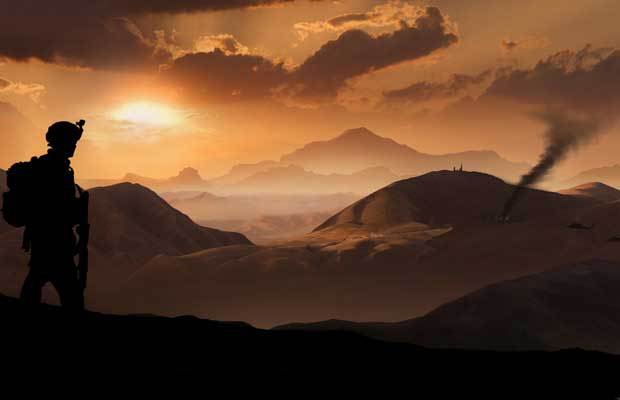Long Term Food Storage Issues in Canada
Food storage has generated a lot of controversy over the decades and will do so over the next decades if SHTF fails to arrive.
How do you tell if someone is a vegan? They tell you!!!
[Disclaimer: I have been a vegan for the last five years and I was a vegetarian for twelve years prior to that].
Meat canning/storing is not my thing nor my focus. That said I have zero intent to be 100% vegan in SHTF but frankly the concept of not being mainly vegan in SHTF for everyone who is prepping is likely unachievable and unhealthy. In SHTF I plan on eating meat, fish, and eggs but not dairy other than goat cheese (I am serious anti-casein- the protein in dairy). In fact I would eat anything to avoid starvation in SHTF and I plan to.
I store what I want to eat and so should everyone. This article is just looking at my specific case and specific circumstances here outside Toronto. Obviously if you live in warmer climes you can plan on a mixed farm and enjoy fats from pork and cattle. This would not really work in an area with a growing season of six to seven months maximum so here are my thoughts on long-term food storage issues in places like Canada.
Fat
Living in Canada one thing I always worried about when storing food for SHTF was fat (fat is oil). I am nowhere near walrus or seal meat so what could I do? Nuts are a possible idea and certainly I have black walnut and acorn near at hand and have experimented with both as a source of fat as well as protein. They take time, effort, and knowledge. Harvesting might be dangerous or impossible depending on the scenario. Squirrels and rodents I should be able to get but they have little to no usable fat. Same with deer but I think they will be very rare near any city for years after SHTF.
Storing nuts and oil seems pointless given the really short shelf life of both. Of course, with notice, I’d hit Costco and buy bulk cooking oil, olive oil, and nuts but five years into SHTF those supplies would be gone or be rancid.
My answer is currently storing coconut oil. Not just any coconut oil but extra-virgin. A little goes a long way in supplying calories and essential fats. Storage is as simple as buying a small bottle or tub (I prefer glass) and placing one in each 5 gallon bucket.
This supply can be used and stored relatively easily in most temperatures provided you keep the container size small. Once opened it will go rancid the same as other sources of fat. It can be frozen, heated, and repeat without any issues provided the container is unharmed.
The link above also gives useful information on telling if the coconut oil has gone off. I had expired peanuts and experimented with various methods of cooking and spicing to get rid of the horrible taste. Nothing worked. Expired oil is truly awful!
Protein
This is worth storing in small amounts. Nothing like a tin of SPAM added to white rice and beans for taste and protein in the apocalypse. Yet really the amount of protein should be very, very small. The SAD (Standard American Diet) truth is most people eat far too much protein for their own health. Excessive protein leads to kidney failure and a lot of other avoidable diseases.
Protein for me is in the category of condiment or small requirement. I mean small here! In SHTF one tin of tuna would be added to one week’s worth of meals per person. Would this make me as weak as a vegan? In SHTF I hope so and you can look up how weak vegan athletes are yourselves. As an ex-ultarmarathoner I can tell you most endurance athletes long ago went vegan or vegetarian.
Most of my added protein would come from beans and quinoa. Long term they are easily stored and reasonably priced. Quinoa in bulk is often available at Costco for $34 Canadian. Yet honestly protein from my garden will supply almost all of my needs and protein is the least important issue in SHTF yet the one many preppers are storing the most aggressively. They would be healthier and better off financially storing kale seeds!
Carbohydrates
I do not use sugar and have not for years. Still I like to think about my preps and it dawned on me a few bags of sugar would actually make a lot of sense in SHTF. A bit added to flour really helps the taste of bread and it is very cheap and stores easily. Again most of my carbohydrates would come from the garden and home-grown potatoes are wonderful! For storage I have lots of white rice and some pastas. This area I am not very worried about.
Of course being Canadian I also store maple syrup which is the best carbohydrate in the world, eh! I have spiles and tubes (food grade) to harvest maple syrup in SHTF once the ability to move around becomes safe. Anyone living near maple trees really needs to think on this and also other sap trees.
Smart Long Term Stores

Can you sprout? It is very easy and very helpful in many SHTF scenarios. Make sure you can do it and have the equipment to do it daily in SHTF. Why not store grains and seeds long-term that you can eat, sprout, and plant? This is as easy as buying organic chia seeds (they need clay pots for sprouting) and putting them in a Mylex™ bag inside some of your food buckets. Most dried beans are easier to cook and healthier to eat after sprouting for a couple of days.
Vitamin C is a key ingredient for us all to live a good and healthy life. Storing it is an issue. Sure have lots of vitamin tablets but consider canning or strong lime and lemon juices. I cannot grow oranges up here but if you can then start now. I plan on using apples a lot in SHTF and storing blackberries and raspberries. These skills will be essentially long-term in SHTF so I have started now. Basic good quality bottles of jam is another essential and smart long-term storage item that I’d have in every food bucket. I cannot stand marmalade but I can added it to white rice easily enough so I store marmalade.
Salt
I am guessing everyone has salt but what about iodine? Those of us who live a long way from the ocean or on land that never was ocean will become iodine deficient in SHTF. Is your salt also a supply of iodine? It needs to be unless you live near the ocean.
I add very little salt to my diet at present but I have a small package of iodized salt in all my buckets for long-term use. I am expecting convenience foods to disappear in SHTF and the large and excessive amounts of added salt we all eat at present will be a memory. Plan for a lot of salt and make it iodized. If you check your preps and it is sodium chloride with nothing else listed and/or does not say “Iodized Salt” then put that aside and use for barter.
Dried Spices

Pepper, garlic, onion, turmeric, etc. are all easily available and store well enough for years If you have not put one in each of your storage buckets you might regret it after a year or more of living off your stored rice and beans. You can also store a lot of small plastic bags (UK coin bags are great for this) and divide up very small amounts for barter in SHTF. There are many spices available and buy one each time you shop. Variety is the aim once salt and pepper are dealt with. Hot spices are great but bottles tend to go off over time so grab handfuls at fat food places. Put them in a Mylex™ bag with lots of oxygen absorbers as their packaging is fast food not apocalyptic! Basil and arugula should be available to you via seeds as should mustard. A quick survey of your local area would find many greens available that will spice up food and help you stay healthy. Purslane and Dandelion are weeds for me but a snip them frequently to add to my salads now. Avoid harvesting near rods, polluted rivers, and dog walking areas!
Conclusion
What do you store as long-term food and why? If you mess this up there’s no quick trip to Costco’s available in SHTF to fix it. Take a hard look at what you have now and think about how you will use it in SHTF. Can you make different textures and flavors easily? Will this food supply vitamins, fiber, carbohydrates, fats, and proteins in variety? Can the food stored be easily extended by wild foraging and/or gardening? When you open it will you be using the entire amount before it goes bad? Sure 5 gallons of X in the bucket makes you feel secure but can you use all 5 gallons before it goes rancid? Pack small Mylex™ bags inside the big buckets so you have both choice and shelf life after opening.
Hopefully my errors and mistakes here will get picked up in the comments section. I am not going to explain or justify my current diet nor why I feel casein is not a great thing to eat. This is about food storage and SHTF not current nutrition! Bon appetite!
Food storage has generated a lot of controversy over the decades and will do so over the next decades if SHTF fails to arrive. How do you tell if someone is





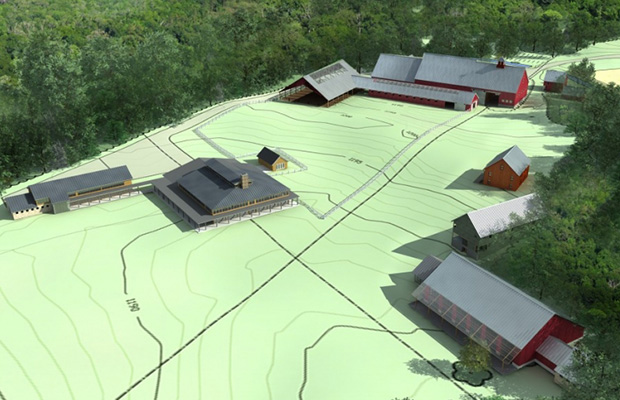
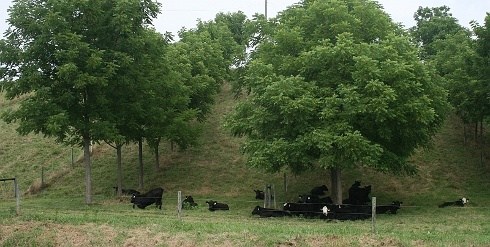
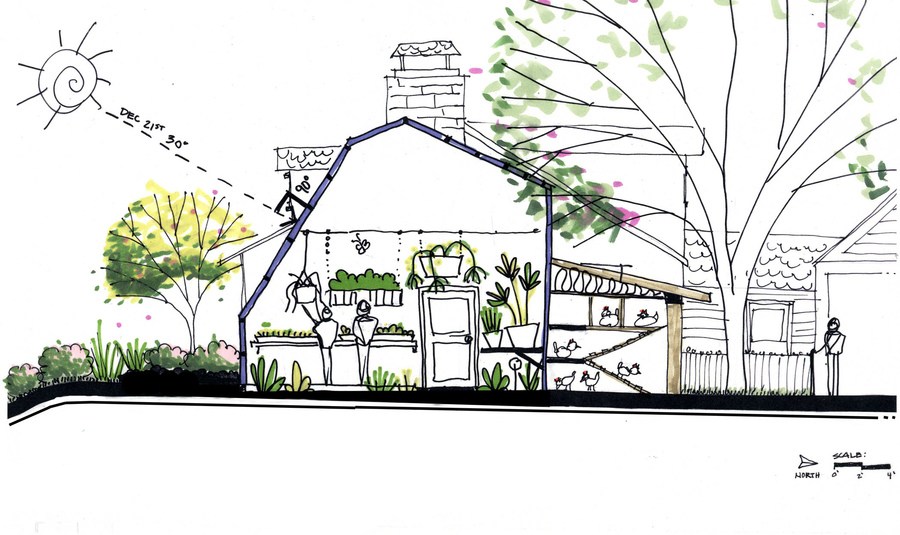
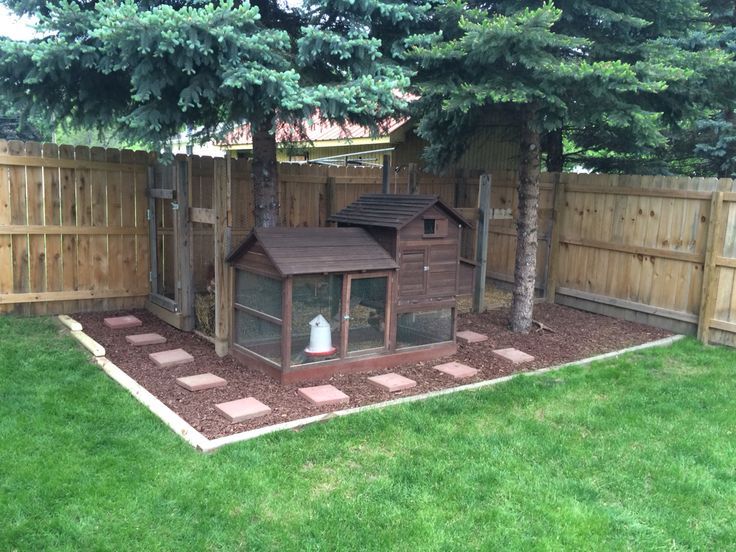
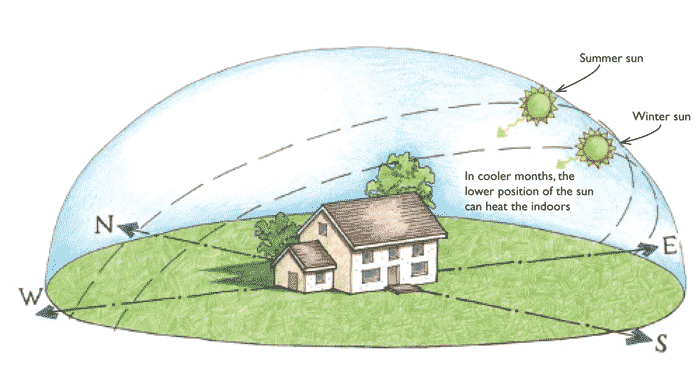
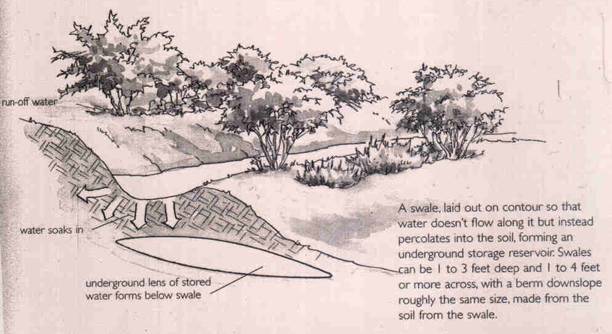
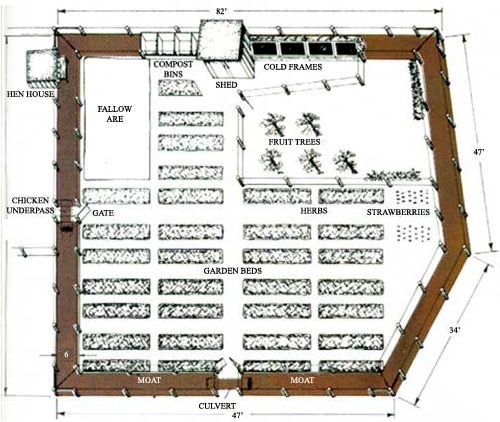
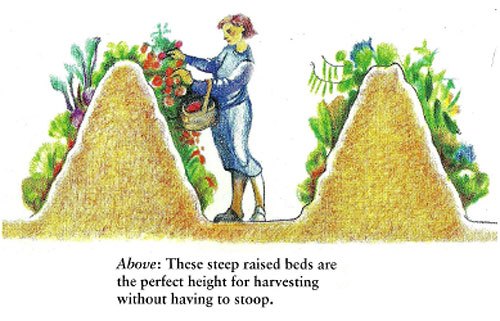
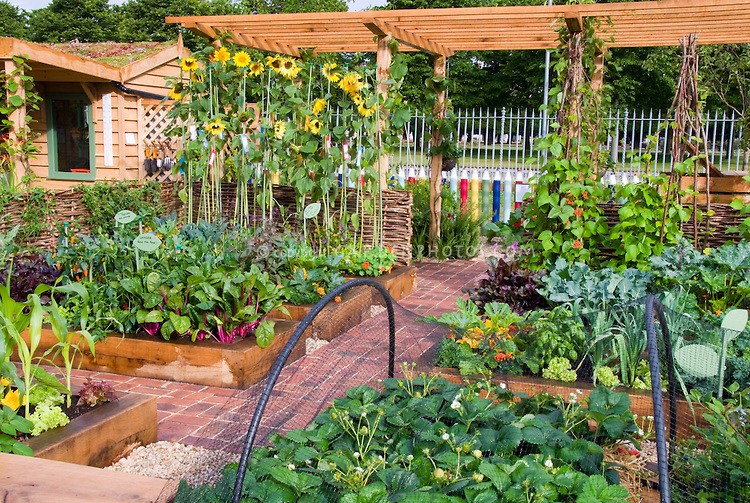
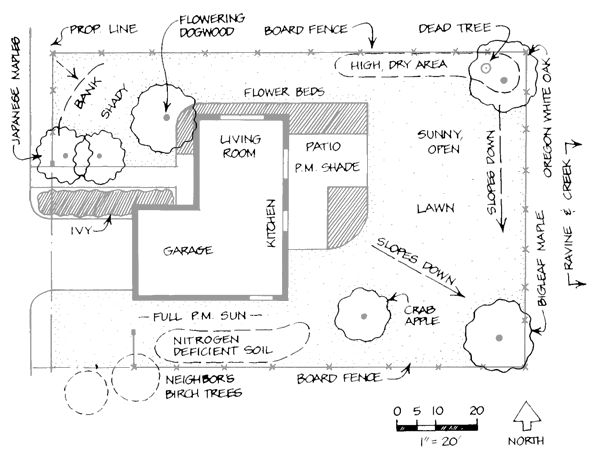


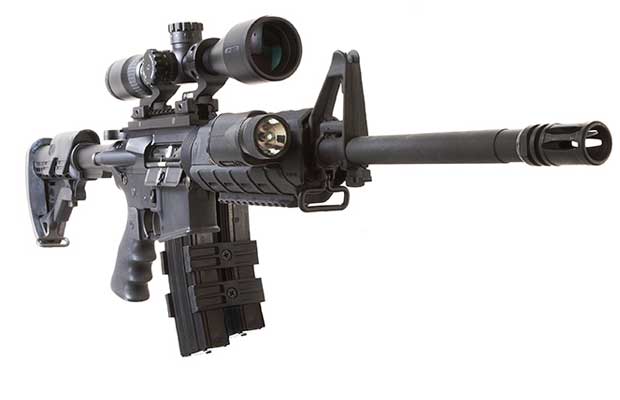
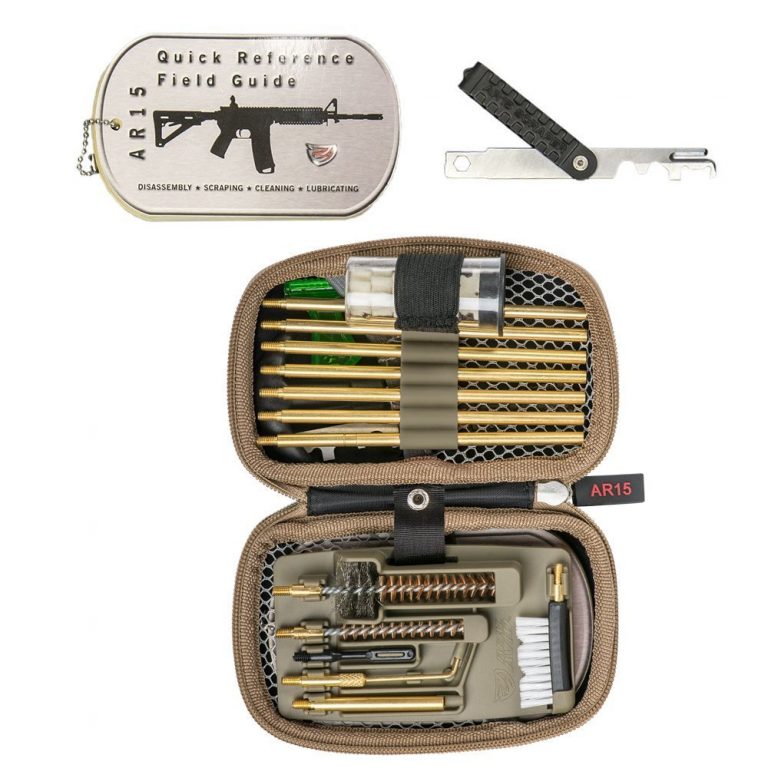
 EOTech XPS2 HOLOgraphic sight.
EOTech XPS2 HOLOgraphic sight.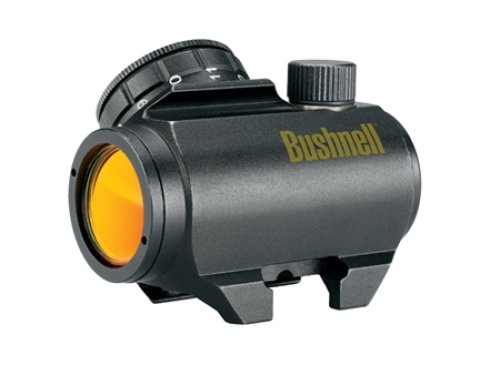 Bushnell Trophy TRS-25. Lower cost alternative to something like the EOTech.
Bushnell Trophy TRS-25. Lower cost alternative to something like the EOTech.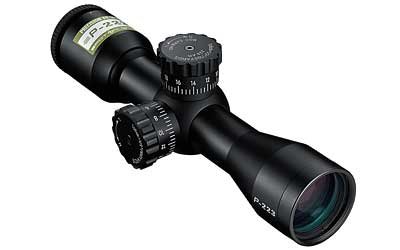 Nikon P-223 3×32 – Great mix of functionality in a scope for the AR-15
Nikon P-223 3×32 – Great mix of functionality in a scope for the AR-15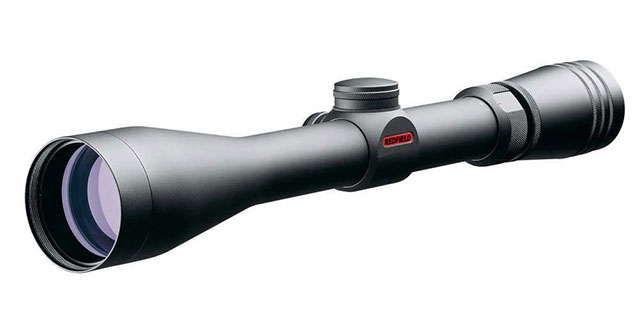

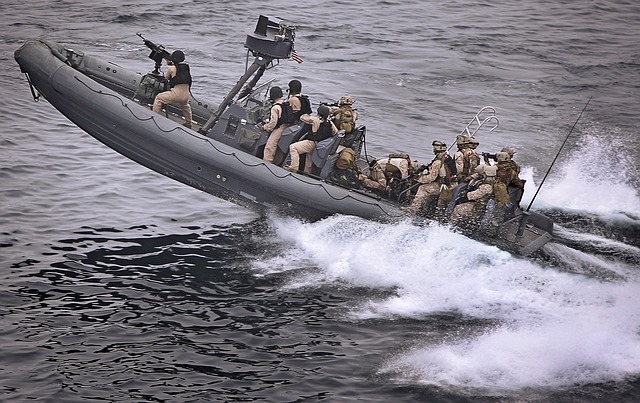 Maybe we don’t get our own stick of Special Forces operators, but a boat could be a great option for many preppers.
Maybe we don’t get our own stick of Special Forces operators, but a boat could be a great option for many preppers.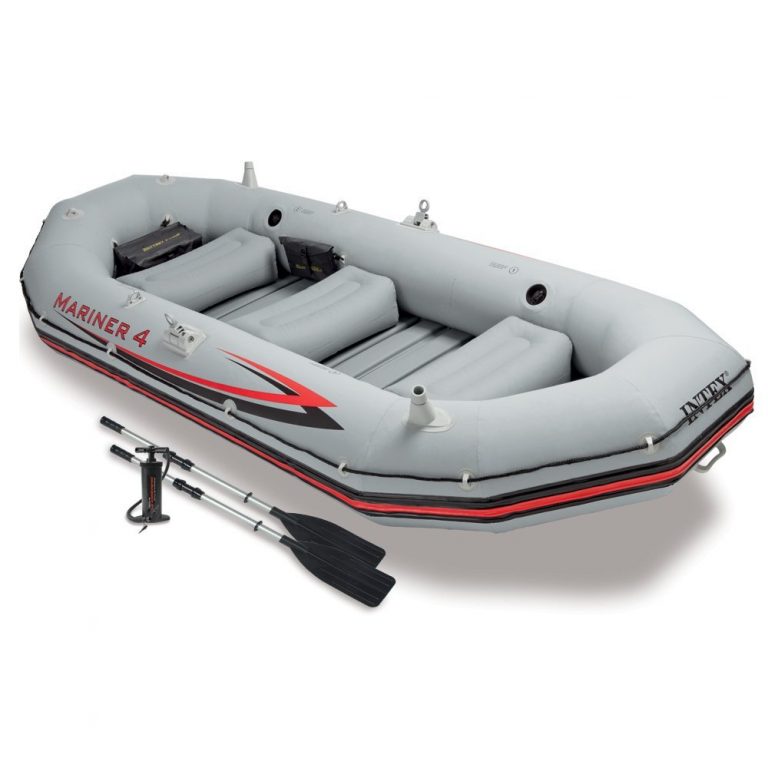
 OFFGRID by Recoil SUMMER 2014 Bug out boat/Urban Survival issue
OFFGRID by Recoil SUMMER 2014 Bug out boat/Urban Survival issue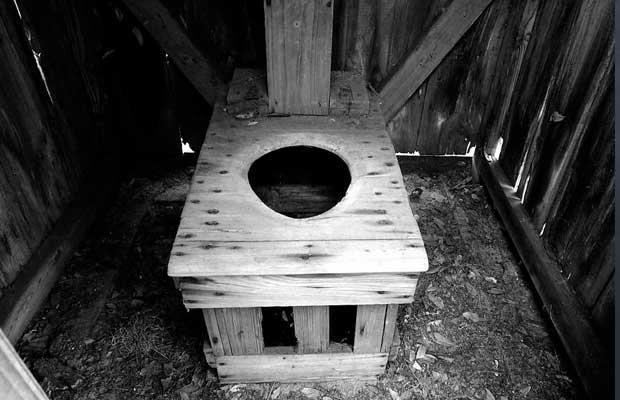

 It doesn’t have to be pretty, but you need to have a plan.
It doesn’t have to be pretty, but you need to have a plan. The basics of keeping your cooking utensils clean and germ free.
The basics of keeping your cooking utensils clean and germ free.
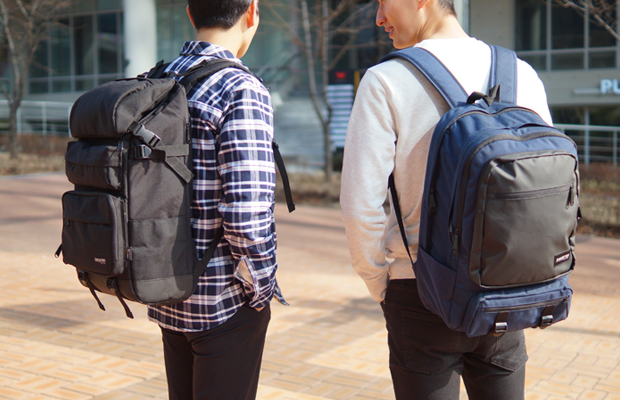
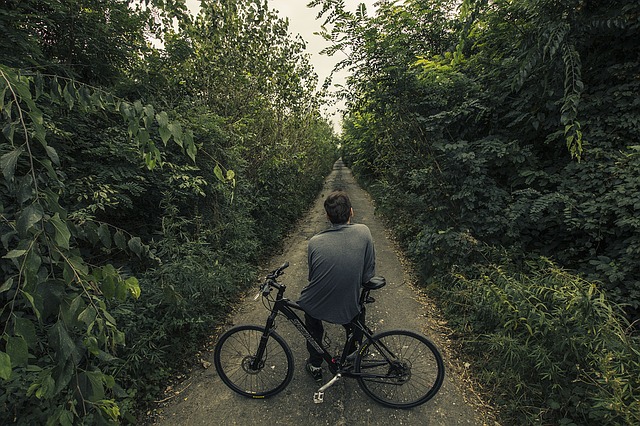 Plan multiple routes you can take away from school back to safety and a communication plan with family.
Plan multiple routes you can take away from school back to safety and a communication plan with family.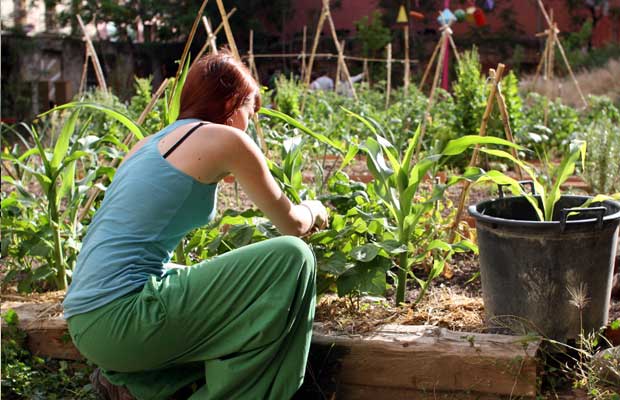
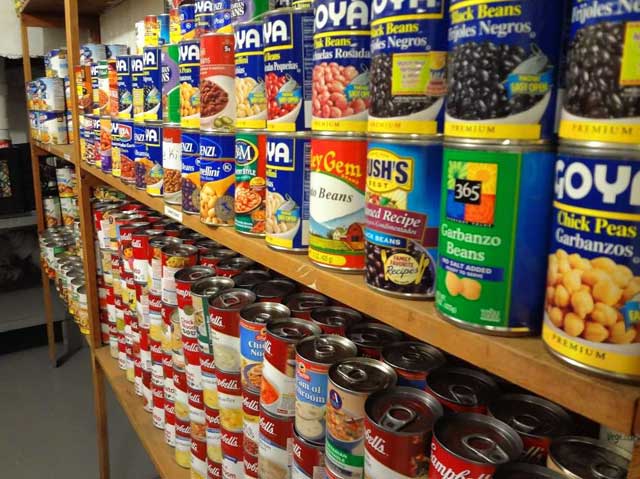 Easy food storage start is to simply buy a little more each week of what you already eat.
Easy food storage start is to simply buy a little more each week of what you already eat.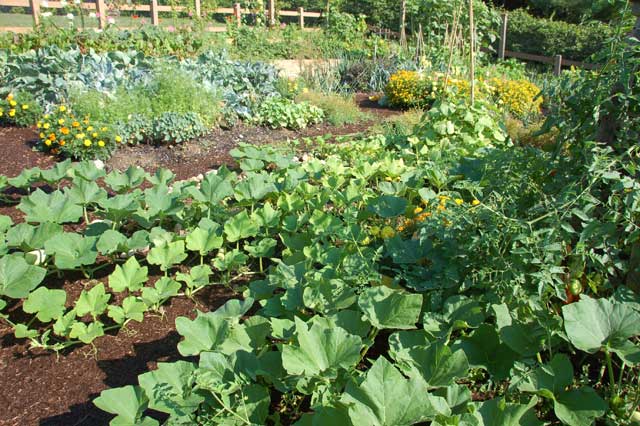 A garden is simply a prepping must-have to live off-grid.
A garden is simply a prepping must-have to live off-grid.

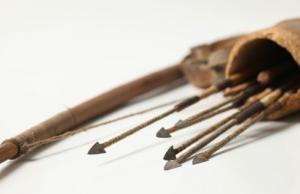
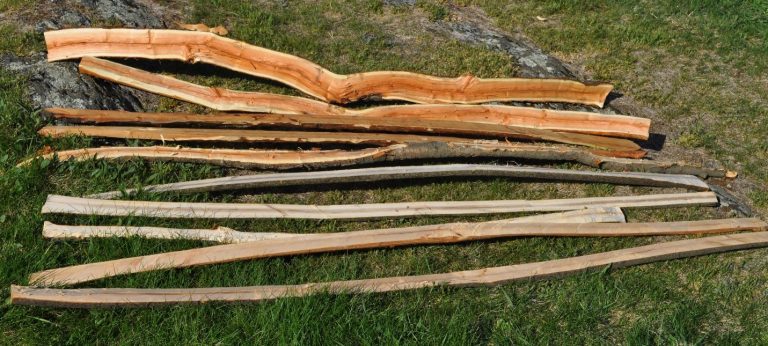 European Yew is suggested as the best material for making bows, but good old Hickory is great also.
European Yew is suggested as the best material for making bows, but good old Hickory is great also.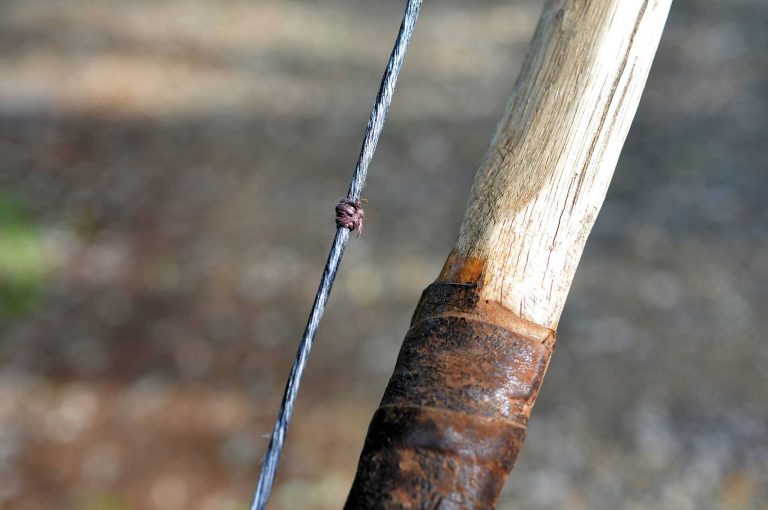
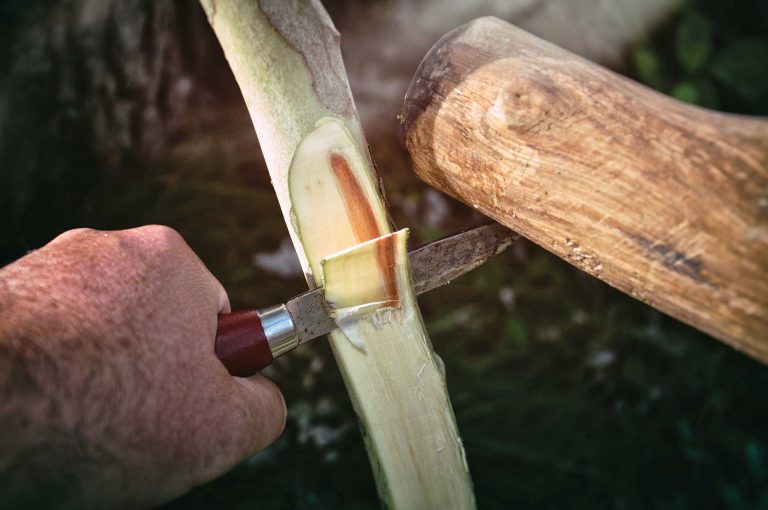
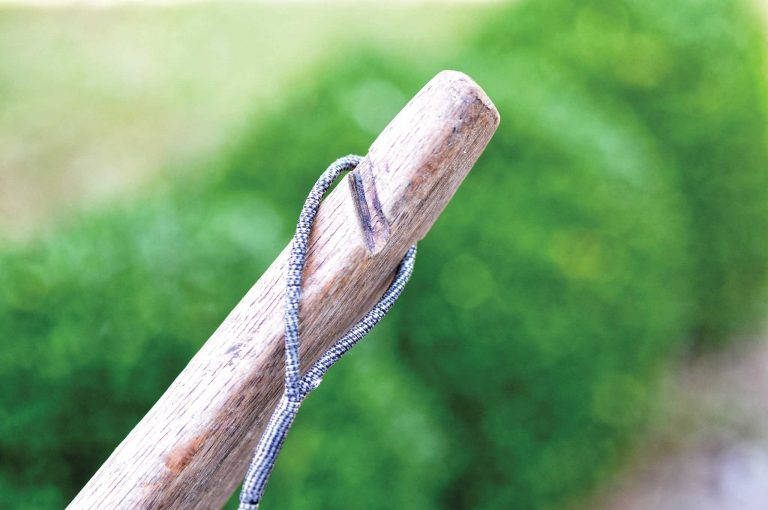
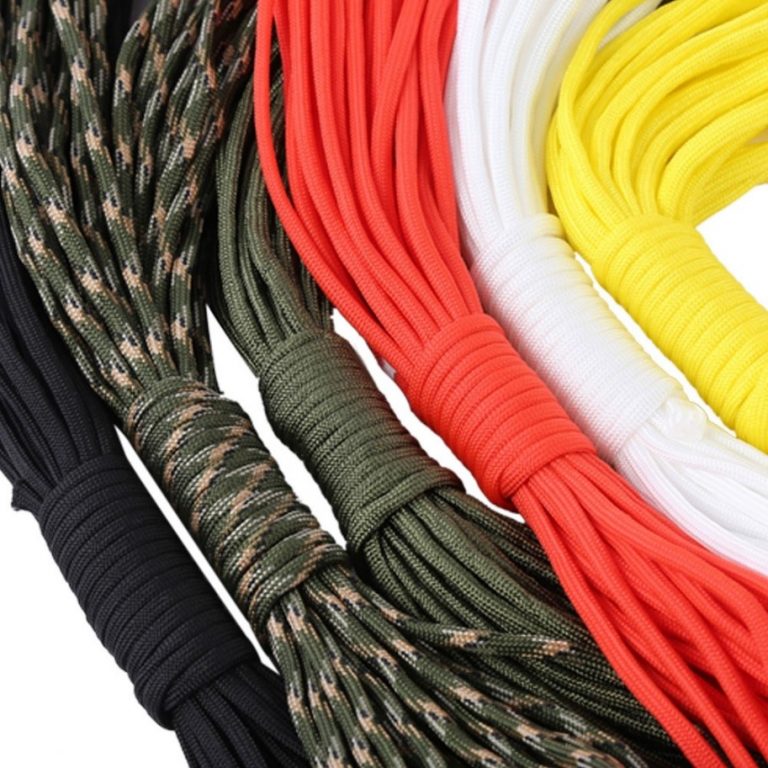
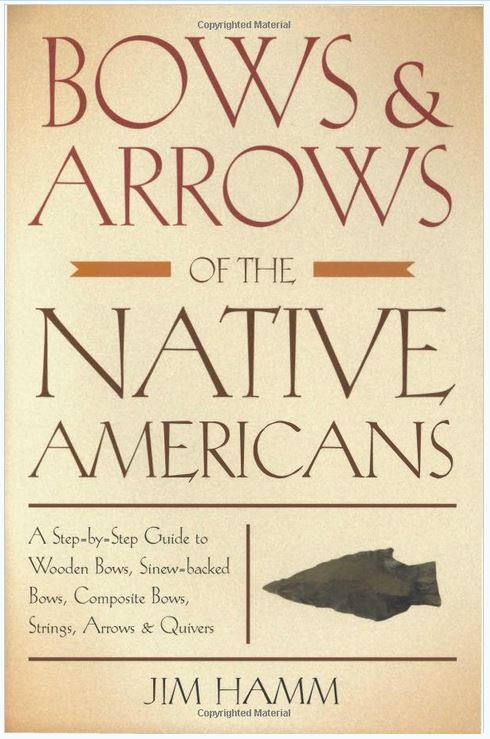
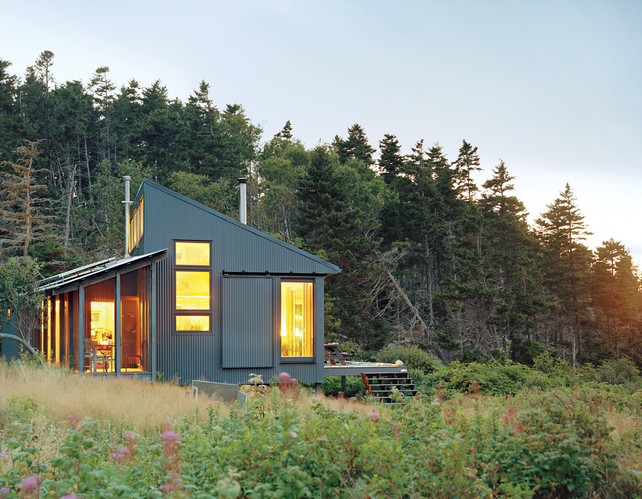

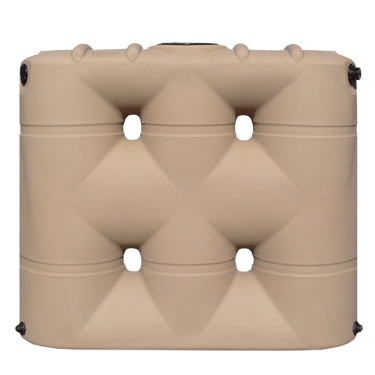 High capacity water storage tanks like this 530-gallon tank from Bushman would solve a lot of grid-down water problems.
High capacity water storage tanks like this 530-gallon tank from Bushman would solve a lot of grid-down water problems.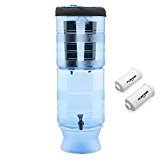 Filtering water doesn’t get much easier than gravity-fed units like this Berkey Light.
Filtering water doesn’t get much easier than gravity-fed units like this Berkey Light.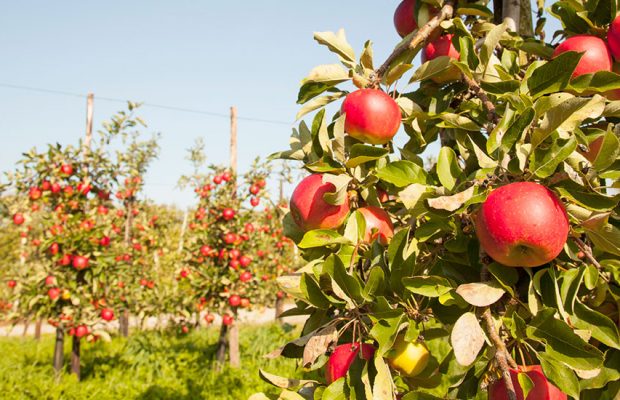

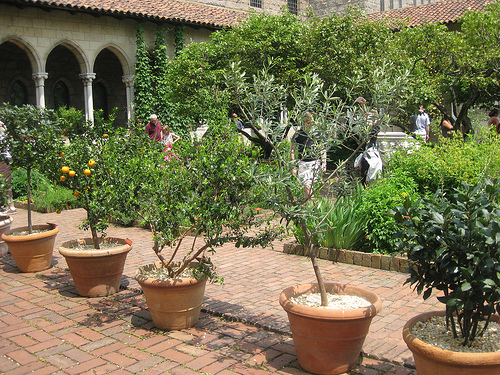
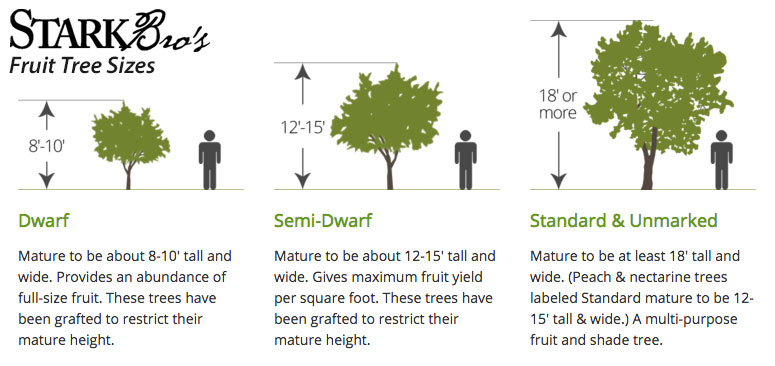 Dwarf and semi-dwarf trees produce the same type and size fruit as standards, just less per tree.
Dwarf and semi-dwarf trees produce the same type and size fruit as standards, just less per tree.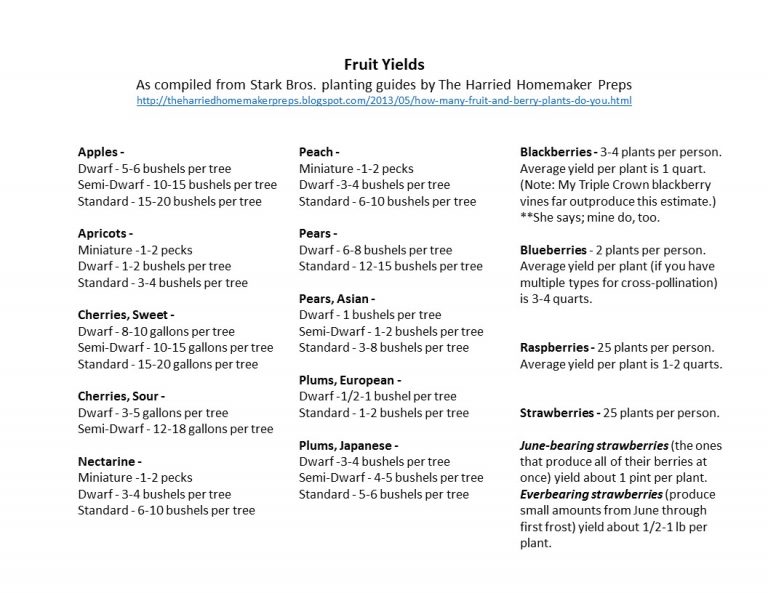 Be aware: Yields vary depending on soil types, nutrients, water, pests, pruning and variety of tree within each species. I halve the numbers from Harried Homemaker and Stark Bros. when presenting estimated to clients.
Be aware: Yields vary depending on soil types, nutrients, water, pests, pruning and variety of tree within each species. I halve the numbers from Harried Homemaker and Stark Bros. when presenting estimated to clients.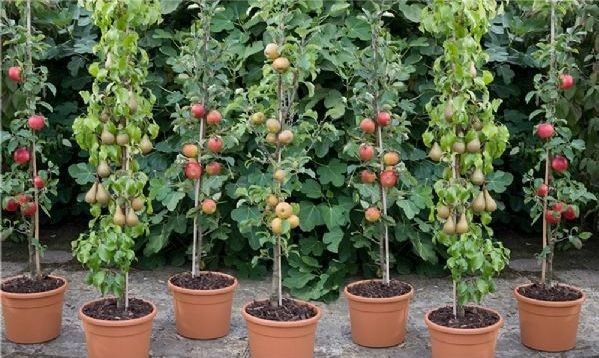 Cordon or columnar fruit is available in several species, and while expensive, it can save space to increase diversity and allow homeowners variety and resilience.
Cordon or columnar fruit is available in several species, and while expensive, it can save space to increase diversity and allow homeowners variety and resilience.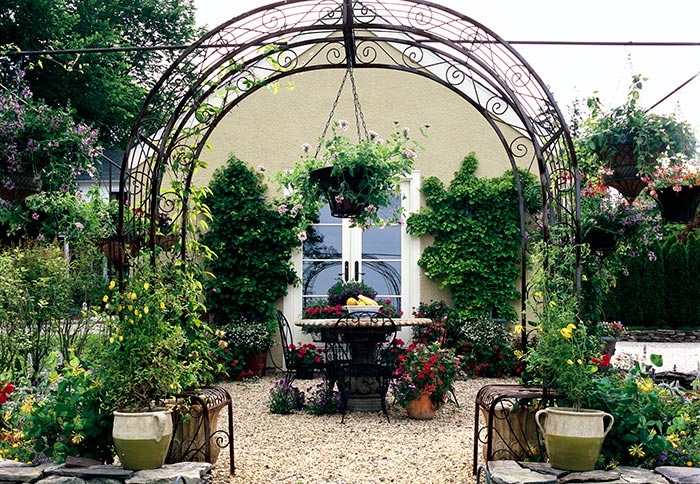 Dwarf, container, trellis and espalier fruit can transform a compound into a more pleasant space, allow perennial production in urban and suburban environments, and let us take our fruit trees and shrubs with us when we move.
Dwarf, container, trellis and espalier fruit can transform a compound into a more pleasant space, allow perennial production in urban and suburban environments, and let us take our fruit trees and shrubs with us when we move.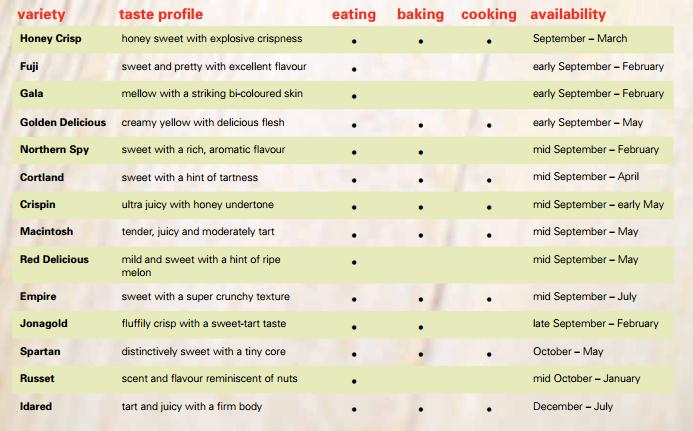 Increases harvest season – One benefit to smaller trees is that we can spread out the harvest season. The common standard tree yields of 10-20 bushels is a lot to deal with inside the 1-3 weeks of the harvest season for each variety, and once it’s in and processed, there’s no more fresh fruit. Instead, we can tailor our home orchard for 3-6 months of fresh produce by selecting varieties from late, mid and early seasons within their species and having a couple of other species with them.
Increases harvest season – One benefit to smaller trees is that we can spread out the harvest season. The common standard tree yields of 10-20 bushels is a lot to deal with inside the 1-3 weeks of the harvest season for each variety, and once it’s in and processed, there’s no more fresh fruit. Instead, we can tailor our home orchard for 3-6 months of fresh produce by selecting varieties from late, mid and early seasons within their species and having a couple of other species with them.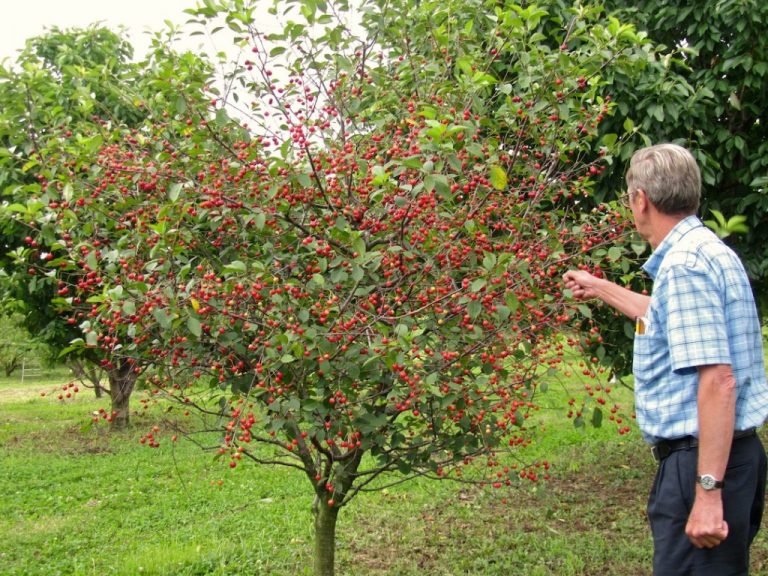
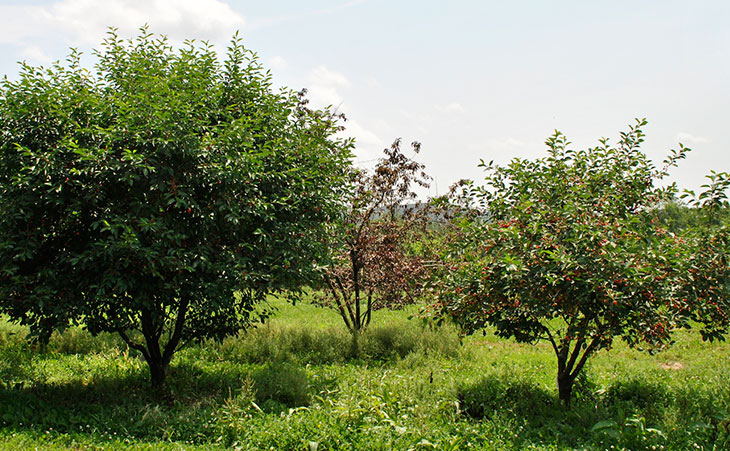 Smaller trees can allow us to increase variety and resilience in the same space. If one species, variety, or specimen is lost or damaged by pests or weather, others may survive.
Smaller trees can allow us to increase variety and resilience in the same space. If one species, variety, or specimen is lost or damaged by pests or weather, others may survive.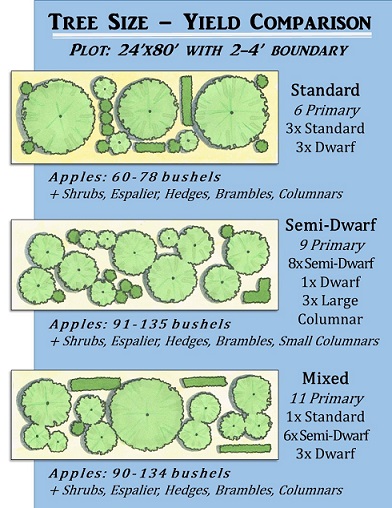 Graphic: Using a mix of semi-dwarf and dwarf trees can increase the total fruit yield in a space as well as create resiliency. *Yield estimates taken from Harried Homemaker Preps’ compilation of Stark Bros. estimates.
Graphic: Using a mix of semi-dwarf and dwarf trees can increase the total fruit yield in a space as well as create resiliency. *Yield estimates taken from Harried Homemaker Preps’ compilation of Stark Bros. estimates.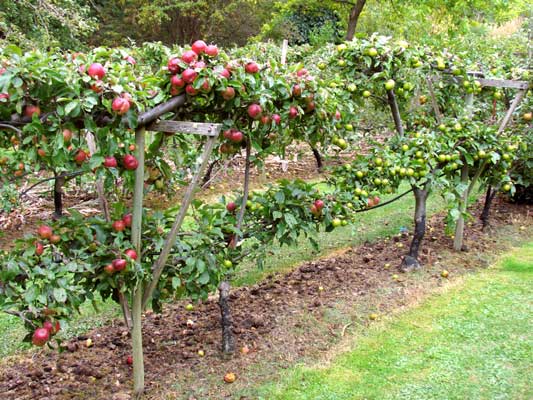 Dwarf and espalier fruit can be trained to hedges, serving multiple functions on our property as well as producing food.
Dwarf and espalier fruit can be trained to hedges, serving multiple functions on our property as well as producing food.